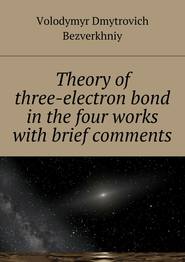По всем вопросам обращайтесь на: info@litportal.ru
(©) 2003-2024.
✖
Review. Benzene on the basis of the three-electron bond. Theory of three-electron bond in the four works with brief comments (review). 2016.
Настройки чтения
Размер шрифта
Высота строк
Поля
bond lengths in ethane, ethylene and acetylene
As usual, the С-С bond multiplicity in ethane, ethylene and acetylene is taken for 1, 2, 3. For the energy of bonds let us take the findings [7, p. 116]:
energies of bonds in ethane, ethylene and acetylene
If we have two variants and we received the set of points and we marked them on the plane in the rectangular system of coordinates and if the present points describe the line equation y = ax + b that for choose the coefficients a and b with the least medium-quadratic deflection from the experimental points, it is needed to calculate the coefficients a and b by the formulas:
(4)
(5)
n-the number of given values x or y.
If we want to know how big is the derivative, it is necessary to state the value of agreement between calculated and evaluated values y characterized by the quantity:
(6)
The proximity of r
to one means that our linear regression coordinates well with experimental points.
Let us find by the method of selection the function y = a + b/x + c/x
describing the dependence multiplicity = f (L) and E = f (L) in best way, in general this function describes this dependence for any chemical bonds.
Let us make some transformations for the function y = a + b/x + c/x
, we accept
X = 1/x,
than we’ll receive: Y = b
+ cX, that is the simple line equality, than
(7)
(8)
n—the number of given value Y.
Let us find a from the equality:
?y = na + b? (1/x) + c? (1/x
), (9)
when n = 3.
Let us find now multiplicity = f (L) for C?C, C?C, C?C.
Table 1. Calculation of ratios for relation Multiplicity = f (L).
1/x
= 0.64808814, x
= 1.543, y
= 1
? (1/x
) = 1.66729469, ? (1/x) = 2.22534781 when n = 3
c = 11.28562201,
b = – 5.67787529,
a = – 0.06040343
Let us find from the equation:
Multiplicity C—C (ethane) = 1.
Multiplicity C?C (ethylene) = 2.
Multiplicity C?C (acetylene) = 3.
Multiplicity C—C (graphite) (L = 1.42 ?) = 1.538 ? 1.54.
Multiplicity C—C (benzene) (L = 1.397 ?) = 1.658.
As we can see the multiplicity C—C of benzene bond is 1.658 it is near the bond order of 1.667 calculated by the method MO [8, p. 48].
It should be noted that the а, b, с coefficients for this y = a + b/x + c/x? function in case of using three pairs of points (х
, у
), (х
у
) and (х
у
are defined explicitly; actually, they (the coefficients) are assigned to these points. In that way we find these coefficients for working further with the equation. For making certain that this dependence y = a + b/x + c/x? describes well the Multiplicity = f (L) and E = f (L) functions it will take only to perform correlation for four or more points. For example, for the dependence Multiplicity = f (L) for C-C bonds we should add a fourth point (Lc—c = 1.397 ?, Multiplicity = 1.667) and obtain an equation with r? = 0.9923 and the coefficients а = – 0.55031721, b = – 4.31859233, с = 10.35465915.






